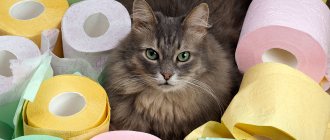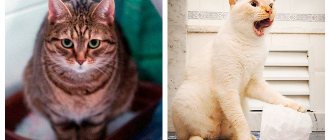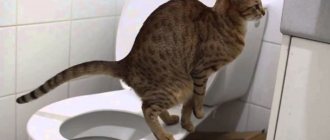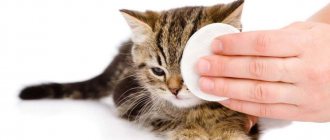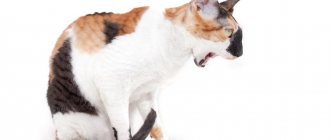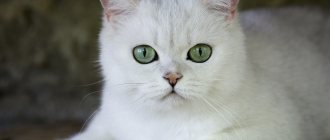Rectal prolapse in a cat is when the underlying layers of the intestine come out through the anus. This disease is often diagnosed in pets due to helminthic infestation, as well as poor diet and long-term chronic constipation. Without timely treatment (for example, manual reduction), rectal prolapse can lead to serious consequences for the pet, including death. Specialists from a veterinary clinic in Moscow talk about how the disease is diagnosed and what methods are used to treat the animal.
Read in this article:
Why does a cat's rectum prolapse? Signs of rectal prolapse Prognosis Diagnosis of the disease How is rectal prolapse treated in a cat? How to prevent the development of rectal prolapse?
Description of the pathology
Under certain conditions, several layers of intestine exit through the anus.
The size of tissue protrusion can vary from a few millimeters to 2-5 cm.
As soon as the organ comes out through the anus, swelling develops. This prevents reduction and restoration of the physiological position.
Kinds
Depending on the degree of prolapse, the pathology is divided into several types. The anal sphincter weakens for various reasons, and during the process of defecation, a protrusion of a section of the lower intestine occurs.
This is a common illness that occurs due to poor diet or problems with bowel movements.
Partial
With this type of pathology, a slight protrusion of the colon mucosa is observed.
Pathology develops after bowel movement. Incomplete prolapse can resolve on its own without human intervention.
Complete
With this pathology, the veterinarian notes protrusion of the entire rectum.
With complete prolapse without manual reduction or other types of correction, the prognosis is unfavorable. The exposed intestinal mucosa is injured and its tissues die. In advanced conditions, blood poisoning occurs - sepsis . If the pathology is treated with any of the methods shown, the cat can be saved.
Why does the intestine need to be realigned?
After examining the animal, the veterinarian decides to restore the physiological position of the organ.
This is due to the fact that with edema, necrosis of the intestinal wall develops due to strangulation.
At-risk groups
Most often, prolapse develops in a kitten under 6 months of age due to intestinal immaturity. Animals at this age suffer from indigestion.
The pathology can develop in cats after prolonged labor during childbirth, or in animals that constantly eat dry food. Pathology also occurs in older animals suffering from diseases of the genitourinary system.
Synonyms
The pathology is often called rectal prolapse or intestinal protrusion.
Causes and symptoms of intestinal inflammation in a kitten
Intestinal inflammation in a kitten is a fairly common disease, which often occurs in an acute form. It should be noted that not only the intestines become inflamed, but also the gastric mucosa. The reasons can be very diverse - here are the main ones that we decided to highlight:
- Starting complementary feeding or introducing an unfamiliar ingredient into the kitten’s diet.
- Eating poor quality food.
- Binge eating. It is believed that kittens do not eat too much, but, alas, they still do not know how to control their appetite, and here you have inflammation.
- Worms can also cause the development of inflammation, and it doesn’t matter whether you took a kitten from the street or purchased an animal of “royal blood”, the parasites don’t care where they breed or whose intestines they injure.
- Poisoning is a common cause of intestinal inflammation, since kittens in the process of exploring the world can get into their mouths both washing powder and a tablet accidentally lying on the floor.
- Infectious diseases can cause intestinal inflammation if the kitten came into contact with sick or street animals, or if careless owners did not take care of vaccinations on time.
- Stress associated with a change of environment while moving to a new home, especially if there is a child in the house and the adults have not built a relationship with the kitten, can also cause intestinal inflammation.
- During the growth period, the kitten needs to sleep a lot, and if he is not given this opportunity, he may respond to discomfort with intestinal inflammation.
- Some cat breeds are prone to intestinal inflammation in childhood, among them are, for example, Sphynx cats.
Thus, there are quite a few causes of intestinal inflammation in a kitten, but the symptoms are so characteristic that they are difficult to miss:
- First of all, this is diarrhea - the kitten runs to its toilet more often than usual, the feces are at first normal, and then become liquid with an admixture of mucus, gas bubbles, and sometimes blood, with a pungent odor.
- The second symptom is a deterioration in the general condition of the animal. The baby's body is hot to the touch, as the temperature rises (the norm for a kitten is 39-40), the kitten is lethargic, sometimes the sounds of peristalsis or the sounds of a falling drop are heard in the stomach.
- The third sign is that the kitten has no appetite and sometimes vomits.
- The fourth is rapid weight loss.
Helpful advice: get your pet used to measuring his temperature immediately after he arrives in your home, in order to know his individual temperature is normal.
Causes of hair loss
There are many factors influencing the development of the disease.
Basically, the provocateurs of prolapse are conditions that require significant stress from the animal during defecation, urination, and during lambing.
Enteritis and endoparasites
As a result of frequent intestinal disorders, irritation of the mucous membrane occurs, weakening of the muscles of the anus, causing prolapse.
Worm infestations are common causes of prolapse in young kittens.
Toxins released by worms cause irritation of the mucous membranes of the large intestine. During defecation, there is a strong tension in the anal sphincter muscles, which causes pathology.
Neoplasms
Oncological diseases also provoke the formation of prolapse. Foreign bodies in the perianal area and trauma can also contribute to this.
Perineal hernia
This pathology is rare in cats. Symptoms of the disease: difficulty defecating, frequent constipation, swelling or swelling in the anus. This is the first thing the animal owner notices. People often come to the clinic when their pet has already started prolapse.
Factors predisposing to the appearance of prolapse
Rectal prolapse occurs in diseases that require the animal to exert effort during defecation, urination, or during childbirth.
Other causes include defects in the intestinal mucosa, impaired coordination of peristaltic movements, and inflammation.
Pathologies in which prolapse develops
Loss does not always occur due to any one reason. As a rule, this is a combination of unfavorable circumstances that contribute to the development of the disease.
Diseases that cause prolapse:
urolithiasis, cystitis;- inflammation or enlargement of the prostate, bladder;
- colitis, proctitis;
- chronic constipation;
- oncology.
These diseases cause the animal to strain during defecation. This increases the pressure in the intestines.
A small part of the rectum exits through the anus, its mucous membrane is turned outward. Sometimes the ligaments that maintain the correct position of the organ weaken, and prolapse does not occur.
Why does a cat's rectum prolapse?
A common cause of rectal prolapse in cats is chronic constipation . This is due to the fact that the accumulation of hard feces not only stretches, but also weakens the walls of the rectum. As a result, constant attempts to defecate, which the pet makes to release accumulated feces, lead to rectal prolapse.
Other reasons that lead to rectal prolapse in an animal:
- Helminthic infestations . Worms and the toxins they secrete irritate the mucous membranes. They provoke straining and strong tension in the muscle layer of the anal sphincter, as a result of which they weaken and cannot hold the rectum.
- Diseases of the large intestine . The most common of them include colitis and proctitis. They lead to damage to the intestines, weakening of the entire body, and in some cases, to prolapse of a section of the rectum: completely or partially.
- Poor nutrition . Feeding your pet exclusively dry low-quality food and violating the drinking regime leads to damage to the mucous membrane and prolapse of the rectum.
- Injuries . Severe damage to the anal sphincter muscles, improper rectal administration of drugs, or the use of irritating drugs can also cause rectal prolapse in cats, and in the most severe forms (with bleeding or ulceration).
- Diseases of the urinary system . These include urolithiasis (UCD) and cystitis. Without timely treatment, they lead to complications, one of which is complete prolapse of the rectum, including tissue death.
- Other reasons . Other factors can also lead to the development of rectal prolapse in a cat. For example, inflammation of the soft tissues surrounding the anus, inflammation of the bladder, enlarged prostate gland, difficult childbirth, etc.
The main risk group includes kittens (up to 12 months), as well as adult cats (over 8-10 years). However, no genetic predisposition to this disease has been identified. If you notice signs of rectal prolapse in your pet, seek veterinary help immediately!
Signs of prolapse
The clinical picture of prolapse is characteristic of this disease. It can be compared to hemorrhoids, but it is important to remember that cats do not have them.
Edema, ulceration of the intestine
Upon visual examination, even the owner of the animal without veterinary education observes that the rectum is protruded, swollen, inflamed, turned red, and ulcerations have formed.
In some cases, the “bump” appears only during bowel movements.
Anal discharge
One of the alarming symptoms is bloody and mucous discharge from the cat’s anus. In advanced conditions, the intestine is torn off.
Postoperative care
The first day after surgery, the animal needs careful monitoring and observation .
It is extremely important to strictly follow your doctor's instructions. Coming out of anesthesia and subsequent rehabilitation can take a lot of time. Set up a house or bed for the animal on the floor . It should be soft, comfortable and warm. The animal's chest and abdominal area should not be compressed.
If there is no prohibition from the veterinarian, place heating pads in the house - the cat often freezes after anesthesia .
You can use special heating pads or make them yourself: plastic bottles are filled with hot water and wrapped in rags so that the animal does not get burned.
Wipe your cat's face daily: the area around the eyes, ears and nose. The pet may not have the strength to perform high-quality hygiene procedures .
The postoperative period involves wearing a bandage-diaper. It is important to ensure that the cat does not remove it. If the animal persistently pulls off the diaper and licks the seams, it is recommended to wear a special collar, which limits the pet’s ability to remove the bandage.
Treatment: methods and means
If treatment is started in a timely manner, a complete recovery of the pet is possible without the development of concomitant pathologies and complications.
Conservative treatment
This approach is chosen in the initial stages of the disease, when there are no dead areas and visible injuries on the prolapsed intestine.
In a clinical setting, manual reduction of the prolapsed section of intestine is performed using anesthesia.
The organ is first washed and treated with antiseptics. To prevent recurrent prolapse, the intestine can be sutured to the anus.
Then a purse-string suture is applied for 5 days, while leaving a hole for the passage of feces. Afterwards, therapy is carried out aimed at eliminating the causes that provoked the pathology.
When is the operation performed?
In case of recurrent conditions, surgical intervention is resorted to. The method is indicated in advanced cases when tissue necrosis of the prolapsed section of the intestine has occurred and the organ has become non-viable.
The dead section of intestine is removed under general anesthesia. The surgeon chooses the most effective method. In this case, the Olivekov method is used.
Amputation of a prolapsed section of intestine
This method of surgical treatment is used in advanced cases, when it is impossible to achieve manual reduction of the prolapsed area or tissue death has occurred.
During the operation, part of the animal's intestine is removed under anesthesia, and then healthy tissue is stitched together. After a successful operation, the intestine is placed in its physiological position.
Then a purse-string suture is placed on the anus for several days to prevent recurrent prolapse.
After amputation, the animal is prescribed laxatives.
Colopexy
This is the suturing of the colon to the wall of the abdominal cavity. The purpose of the operation: to create a fusion of the intestinal lining and the abdominal wall. This helps prevent the colon from moving backward.
Indications: recurrent rectal prolapse.
With the correct choice of conservative or surgical intervention, the treatment prognosis is favorable.
Diagnostics: basic methods
At the first signs of illness, you should consult a doctor.
If a polyp is discovered or your cat’s rectum has prolapsed, you should see a veterinarian in order to begin treatment for the pathology in a timely manner. If there is a problem, a specialist examines the damaged area and assesses the severity of the disease. It is important to determine whether the disorder can be overcome conservatively or whether surgery will be required. To make a final diagnosis, the cat is prescribed the following diagnostic procedures:
- general and biochemical blood tests;
- laboratory examination of stool;
- colonoscopy;
- X-rays of the abdominal cavity;
- Ultrasound diagnostics of the gastrointestinal tract of a cat.
Caring for your cat after surgery
During the rehabilitation period, cats are prescribed antibiotics.
After resection of part of the intestine, special anesthetic gels are injected into the anus. This promotes normal bowel movements. To prevent the animal from licking the operated area, it is given special diapers in the form of a bandage.
The pet is provided with peace and warmth; hypothermia should be avoided during this period.
Nutrition as a component of treatment
The food should be gentle, the products should be light, ground, in a mushy or liquid state.
Dry food is not given to cats at this time. The animal is fed often, but in small portions.
Prevention
Most often, problems with the gastrointestinal tract lead to rectal prolapse. To avoid them, it is necessary to provide the cat with a complete and balanced diet, especially for kittens under one year old. Cats can be fed natural food or commercial food.
You might be interested in: What causes a cat to develop a rash on its stomach?
The pet needs to be given premium and super-premium food. Economy class industrial feeds are poorly balanced and contain various harmful additives. They often lead to digestive disorders and the development of urolithiasis.
Cats that eat only dry food should always have clean drinking water freely available.
A natural diet should consist of the following products:
- Meat (chicken, turkey, lean veal) and offal.
- Cereals.
- Low-fat fermented milk products.
- Vegetables.
- Cats should not be given fish more than once a week. It must be a sea fish from which the bones have been removed.
The following should be completely excluded from the diet:
- sweets (especially dark chocolate, which is poisonous to cats);
- potatoes and legumes;
- fatty pork and smoked meats;
- chicken tubular bones;
- salt and spices;
- milk after the kitten is 4 months old.
It is also necessary to periodically prevent helminth infection. Anthelmintic drugs should be given even to animals that do not go outside, but constantly live at home. Infection can occur through the owner's street clothes.
The drug prescribed by the veterinarian is given to the cat in the morning on an empty stomach. You can feed the animal a couple of hours after this. Preventive deworming should be carried out every 3-4 months. This is especially true for street animals. If, after deworming, worms come out in the feces, the cat should be given the tablet again after 10-12 days.
There should be no freely accessible items that animals can swallow. Cellophane bags, threads, and New Year's rain are especially dangerous.
The vaccination schedule should be monitored. The first vaccinations are given to a kitten at two months of age. An adult animal is vaccinated once a year, regardless of whether the cat has free access to the street or is constantly at home.
You should also pay close attention to the general health of the animal.
Symptoms that indicate that your pet needs to be seen urgently by a doctor:
- frequent constipation or diarrhea;
- frequent vomiting;
- decreased activity;
- increased salivation;
- change in wool quality;
- increased body temperature;
- bad breath;
- restless behavior of an animal for no reason.
Don't ignore your pet's health problems. Most diseases can be completely cured only in the first stages.
How to prevent prolapse
Prevention of hair loss is based on preventing the development of dangerous diseases that weaken the sphincter muscles.
Worm infestations
This point should be given special attention, since helminths affect cats of any age.
Most intestinal pathologies develop due to parasites. Once a quarter, it is recommended to submit feces for analysis to determine the presence of worm eggs. Afterwards deworming is carried out.
It is necessary to regularly treat your pet for fleas, as they are carriers of certain types of parasites.
Timely treatment of diseases
If you detect any signs of ill health in your cat, you must promptly contact a veterinary clinic.
Advanced diseases of the intestines and genitourinary system often provoke this pathology. Only surgery will help here.
Balanced diet
It is important to choose good food for your pet.
Food should not cause constipation or frequent diarrhea. After consultation with a veterinarian, a cat with digestive problems may be prescribed probiotics and other medications to improve digestion . You should also stop using dry food on an ongoing basis.
How long does a kitten get sick with intestinal inflammation?
It should be remembered that if even one of the listed symptoms appears, the animal needs help immediately: due to their low body weight, kittens “burn out” very quickly, as dehydration increases and, as a result, heart failure develops.
The age of the baby, how much it weighs, the causes of the disease, the severity of the symptoms and how quickly the owners started treatment determine how long the kitten is sick with intestinal inflammation.
The disease is especially difficult for kittens under the age of 4 months, but older animals can also suffer for a long time and severely if treatment is not started when the first signs of the disease appear. With timely treatment and proper care, the disease can last 2-3 days, but if it is advanced and the animal’s condition is severe, treatment is delayed for several weeks.




